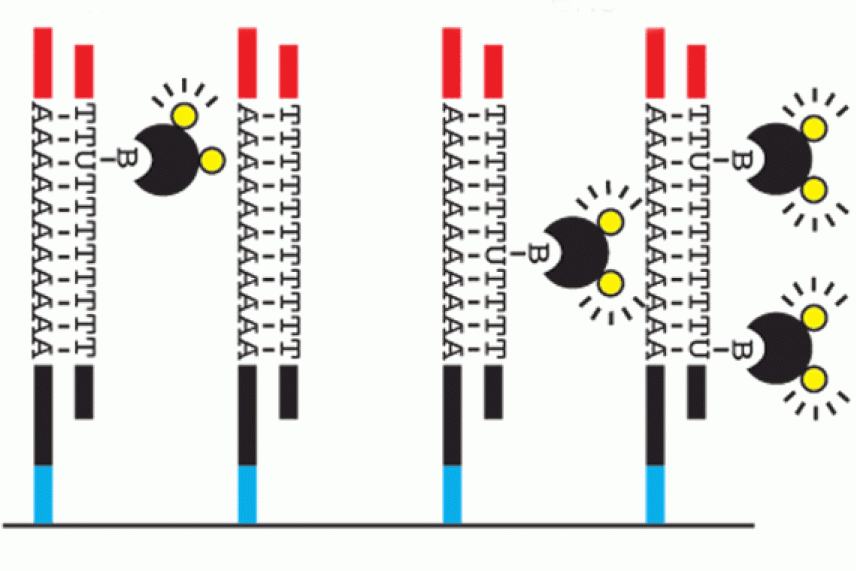A protein-production tale of the tape: separating poly(A)-tail length from translational efficiency

Diagram of high-throughput sequencing-based method that measures the poly(A) tails of individual messenger RNA molecules.
Courtesy of Nature
CAMBRIDGE, Mass. – In higher animals, an embryo’s protein production immediately after fertilization relies on messenger RNAs (mRNAs) inherited from the mother. But shortly thereafter, the tiny organism undergoes a profound shift as it activates the transcription of its own genome during the maternal-to-zygotic transition (MZT). Whitehead Institute researchers have now determined that another shift—a change in how mRNA translation is controlled—happens shortly after this same point in development.
“This switch in the nature of translation control is reminiscent of what we know about transcription control and its timing,” says Whitehead Member David Bartel, who is also a Howard Hughes Medical Institute investigator and a professor of biology at MIT.
When cells manufacture proteins, they first use DNA as a template to create mRNAs. In this process, protein-coding genes are first copied into RNAs, which are then modified by tacking on a string of adenosine monophosphate molecules to create what’s known as a poly(A) tail on the end of each RNA. The cell’s translation machinery then decodes the mature mRNAs, using this information to make the prescribed proteins.
Previously, scientists believed that the length of an mRNA’s poly(A) tail affected how efficiently an mRNA would be translated—the longer the poly(A) tail, the greater the protein production. This theory was extrapolated from studies of gene translation in early embryos, in part because little research had been conducted in organisms after the MZT. The unavailability of technology for high-throughput measurement of poly(A)-tail lengths held back research in this area.
Now, this latest Whitehead research calls this theory into question. Using a high-throughput method he developed, Alexander Subtelny, a graduate student in Bartel’s lab, documented the length of poly(A) tails on millions of mRNAs in cells from a variety of animals, including mice, frogs, zebrafish, and humans. At the same time, Stephen Eichhorn, also a graduate student in Bartel’s lab, looked at how often the mRNAs were translated. As Subtelny and Eichhorn reported recently online in the journal Nature, poly(A)-tail length and translational efficiency show the expected relationship in very early fish and frog embryos. The surprise was that poly(A) tail length does not impact translation in cells that have matured beyond the gastrulation stage of the embryo in the examined species.
This fact may also explain seemingly conflicting accounts of how RNA snippets, called microRNAs, affect translation. MicroRNAs adjust protein output by interacting with mRNAs, both by repressing the translation of mRNAs they pair with and by destabilizing these mRNAs. Subtelny and Eichhorn examined microRNA function in early zebrafish embryos through the gastrulation stage. In pre-gastrulation embryos, microRNAs reduced translation by trimming the poly(A) tails of their target mRNAs, whereas after gastrulation, microRNAs destabilized their target mRNAs.
“Our results may cause people to rethink the mechanisms of gene regulation that involve the poly(A) tail in most cells,” says Subtelny, who with Eichhorn is a co-author of the Nature paper. “But we think that some cells, including nerve cells and oocytes, may have gene regulation similar to what we’ve observed in the early embryo.”
Although Subtelny and Eichhorn believe that studying variability of gene regulation would be interesting, both are intrigued by something more basic.
“We don’t know what the mechanism behind this switch in gene regulation is, and we want to figure that out,” says Eichhorn.
This work is supported by the National Institutes of Health (NIH grant GM067031).
* * *
David Bartel is a Member at Whitehead Institute for Biomedical Research, where his laboratory is located and all his research is conducted. He is also a Howard Hughes Medical Institute Investigator and a professor of biology at Massachusetts Institute of Technology.
* * *
Full Citation:
Subtelny, A. O.*, Eichhorn, S. W.*, Chen, G. R., Sive, H., & Bartel, D. P. (2014). Poly (A)-tail profiling reveals an embryonic switch in translational control. Nature, 508(7494), 66-71.
* These authors contributed equally.
Topics
Contact
Communications and Public Affairs
Phone: 617-452-4630
Email: newsroom@wi.mit.edu


